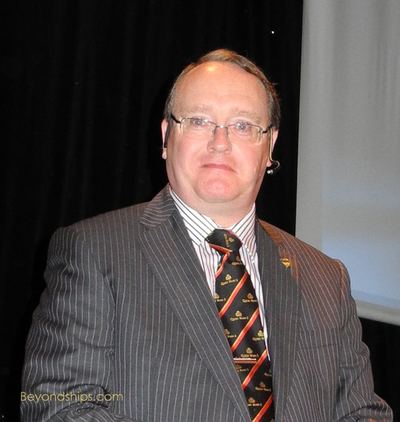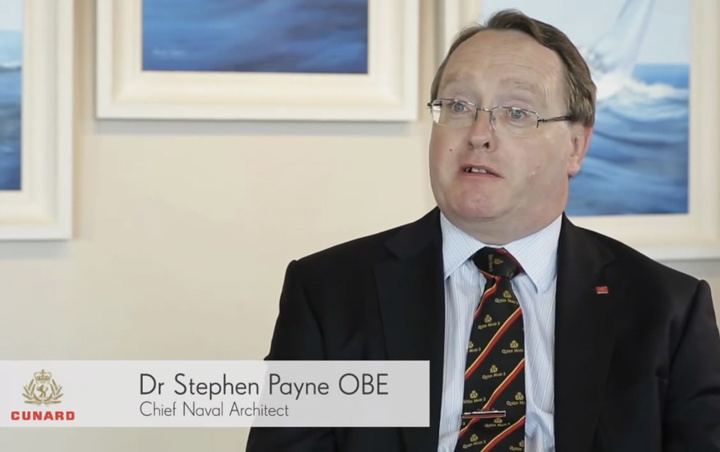Nationality British Role Naval architect Name Stephen Payne | Citizenship United Kingdom | |
 | ||
Born c. 1960 Greater London Practice name PFJ Maritime Consulting Ltd (2011-present) Employer(s) Carnival Corporate Shipbuilding (1985-2010) Significant projects MS Rotterdam (VI), passenger ship design Books RMS Queen Mary 2 Manual: An Insight Into the Design, Construction and Operation of the World's Largest Ocean Liner | ||
Engineering discipline Ship Science | ||
Stephen payne naval architect
Stephen Payne, OBE, RDI, FREng, FRINA is a British naval architect. He has worked on the designs of approximately 40 passenger ships for the Carnival Corporation, including the Cunard ocean liner RMS Queen Mary 2. He is currently an independent maritime consultant and is an educational advocate for engineering careers.
Contents
- Stephen payne naval architect
- Stephen payne titanic revisited 1912 2014
- Background and education
- Professional career
- Engineering Advocacy
- Awards and honors
- References

Stephen payne titanic revisited 1912 2014
Background and education
Stephen Michael Payne was born in London, England circa 1960. He was educated in the local council schools including the Catford Boys’ School, where two of its instructors would have a key role in shaping his career. His interest in ocean liners began at age 5 when the BBC children’s television program Blue Peter featured a tour of the RMS Queen Elizabeth. He would later state that he was immediately captivated by the ship. His interest in ships intensified during a 1969 family visit to the then new Queen Elizabeth 2 in Southampton where he also observed the SS United States, on one of her last transatlantic crossings, arriving in port. In 1972 the program’s magazine described the destruction by fire of the ex-Queen Elizabeth in Hong Kong harbor and ended with the statement “…nothing like her will ever be built again.” With encouragement from a Catford English instructor Payne wrote a letter of complaint to the program arguing that they were wrong, another ship to rival her would indeed be built and he would design it. The program applauded his ambition but cautioned him not to be discouraged if it never happened.
When the time came for him to consider university studies however his career counselors discouraged Payne from any engineering career as it was then seen as having limited job prospects. They advised him to instead study chemistry and he enrolled at Imperial College London. After one year of study he met with his former physics instructor from Catford who agreed that Payne had been badly advised, and helped him obtain funding to transfer to the University of Southampton’s Ship Science program. While there, he also enrolled in the University Royal Naval Unit to experience how ships responded at sea. After graduating in 1984 with a B.Sc.(Hons) in ship science, he accepted a position at Marconi Radar. His role was to advise the company on aspects of ship motion and ship design.
Professional career
Payne began his work with Carnival Corporation in January 1985 when employed by Technical Marine Planning, Ltd, then a London-based consultancy firm under contract with Carnival for the design and construction supervision of its new ships. (By 1995 the firm was absorbed into Carnival and became its newbuild department.) His first assignment was to assess stability of the MS Holiday. He next became a member of the design team for the Carnival Fantasy class ships which entered service starting in 1990. The last two Fantasy ships, Elation and Paradise, were equipped with ABB Azipod thrusters rather than traditional shaft drives, a development which influenced his later work. His next major project was the design of Holland America Line’s new flagship MS Rotterdam VI where he was project manager. Payne designed the new ship with twin funnels, a tribute to the 1959 SS Rotterdam V. Following completion of the Rotterdam, Payne was project manager for the Costa Atlantica and the Spirit class ships.
In May 1998 Carnival acquired the Cunard Line, and Payne was given charge of designing the new ocean liner Queen Mary 2 (QM2) to replace the aging Queen Elizabeth 2 as Cunard's transatlantic liner. Payne's design was heavily influenced by past Atlantic liners. "I have this philosophy that to get things right the first-time, you need to have an appreciation for history - of what has been done before." QM2 has a breakwater adopted from the Normandie and split engine rooms to avoid having a single point of failure. "The bridge, the mast, and the funnel are all loosely based on the Queen Elizabeth 2 and I felt it particularly important to echo some of the similarities between that ship and this one to create the lineage progression." On three occasions Carnival's board halted the project as they did not consider it commercially viable. Payne refined the design and instituted several innovations to justify the new liner's construction cost. He placed the new ship's public spaces near the water line. This allowed for a premium fare balcony, rather than porthole, cabins to be placed in the hull yet high enough to have a margin of protection from the sea conditions of the north Atlantic. Payne also created more revenue-producing interior space by removing one engine room from the initial design and instead using gas turbines at the base of the funnel. Podded propulsion, rather than shaft drives, was used to free up even more interior space and offered greater fuel efficiency and maneuverability. Spectacular public rooms, restricted to only first class passengers on the great twentieth century liners, were open to all passengers. QM2 was delivered to Cunard in December 2003, on time and under budget.
During the design phase of Queen Mary 2 Payne was appointed a member of a safety Innovation Group for the UK Maritime and Coastguard Agency. His next major project was to lead the design team for the Seabourn Cruise Line Odyssey class ships which entered service starting in 2009. Carnival's later newbuild contracts would stipulate podded propulsion as they offered fuel savings and superior maneuverability compared to traditional shaft drives. Payne would later state, "I have yet to meet a ship's master who is familiar with pods that doesn't prefer them to shafts, rudders and stern thrusters."
In 2010, Payne left Carnival and became a founding member of the consultancy PFJ-Maritime Consulting Ltd. As a maritime consultant Payne has been involved in the proposed Project Orient Limited, shipping law, passenger vessel safety, and future developments for shipping propulsion. He is also an industry consultant for the emergence of Asian shipyards for ship building and refurbishment.
Engineering Advocacy
Payne served as a governor of Quilley School prior to its merger with Crestwood College. He was a founder of Future Engineers, an educational outreach program which promotes awareness of engineering careers for youth. In 2011, he became a member of the Board of Trustees of the Webb Institute (Glen Cove, New York). Between 2012 and 2016 Payne was President of The National STEM Skills Passport.
Awards and honors
In 2004, Payne was awarded the Civil Order of the British Empire (OBE) by Queen Elizabeth II for his service to the shipping industry. He also received professional and academic awards:
Payne is a Chartered Engineer (CEng) and a Freeman of the City of London.
